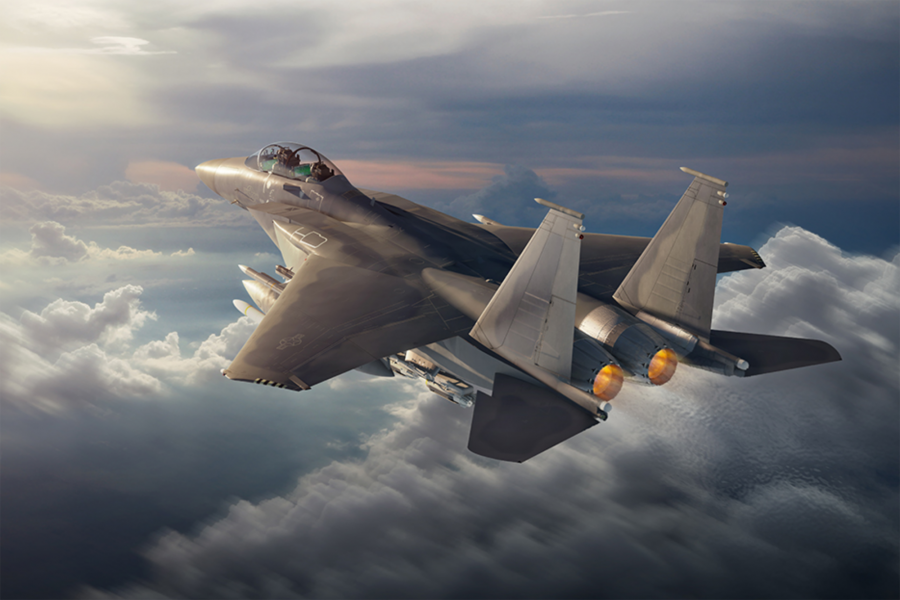The Air Force will have companies compete to provide engines for the new F-15EX, moving way from its original plan to award the work sole-source to GE Aviation.
In a “sources sought” notice issued May 15, the Air Force is looking for companies to bid on a requirement for up to 461 engines to power 144 Boeing-made F-15EX fighters, with responses due June 8. The announcement formally opens the door for Pratt & Whitney, now part of Raytheon Technologies, to compete for the work.
The Air Force initially planned to buy the engines sole-source from GE Aviation, as that company supplies the F110 engines on the F-15QA—the Qatari model on which Boeing is basing the F-15EX. A sole-source strategy was appropriate, service officials said, in order to accelerate the acquisition because the F-15C fleet is rapidly aging out of the inventory and the Air Force doesn’t want a gap in capability.
The Air Force will still award GE a sole-source contract for the first lot of F-15EX engines. An Air Force Materiel Command spokesperson said this is necessary “to meet the unusual and compelling urgent need for engines, which can be immediately certified for use in the F-15EX Lot 1 aircraft without delaying their rapid fielding schedule.”
With its sources sought notice, AFMC said through a spokesperson it’s now conducting “market research” that will “inform the F-15EX program’s acquisition planning and determine whether a competition is appropriate.”
To compete, Pratt would have to integrate its F100 engine with the F-15EX’s digital, fly-by-wire flight control system. The solicitation said that while integration could take place “concurrently” with production, the engine would have to be certified for the aircraft before delivery.
Pratt filed a protest with the Government Accountability Office in February, saying it could meet the Air Force’s timetable for engine delivery and there was no reason the service should pursue the acquisition sole-source. The company noted that all Air Force F-15E models are flying with its F100 engine.
The GAO was due to rule on the protest by May 18, but a GAO official said the Air Force gave up its sole-source strategy in March. The GAO dropped its consideration of Pratt’s protest at that point.
The notice said the Air Force wants the powerplants delivered at a rate of four per month starting in 2023 and progressing to six per month by mid-2026, a rate which would hold until the last five are delivered in May 2030.
The Air Force set minimum performance parameters for the F-15EX engine:
- Maximum thrust: No less than 28,500 pounds
- Intermediate thrust: No less than 17,000 pounds
- Maximum Diameter: No more than 46.5 inches
- Maximum weight: No more than 4,000 pounds
Both Pratt and GE’s engines can meet those requirements.
In a statement, GE Aviation noted that its F110-GE-129 is “the only engine certified for the F-15 Advanced Eagle” and is “ready to serve the U.S. Air Force right now.” The engine increases mission readiness rates and capability because of its “cost-effective, high-performance operation, as well as its safety and reliability,” the company said.
The F-110 powers “86 percent of F-15s delivered globally in the last 15 years,” as well as 70 percent of the F-16C/D aircraft in the USAF inventory. The F110 family has passed 10 million flight hours and some 3,400 have been ordered worldwide, the company said.
Pratt, in a statement, said its F100-229 “is the exclusive propulsion system for the USAF’s entire fleet of operational F-15s; and its industry-leading safety, reliability, and performance delivers superior capability to the warfighter.” Moving toward a competition for the engine is “a critical first step in achieving rapid fielding objectives,” the company said.
Editor’s Note: This story was updated at 12:26 p.m. on May 21 to include a comment from an Air Force Materiel Command spokesperson.
